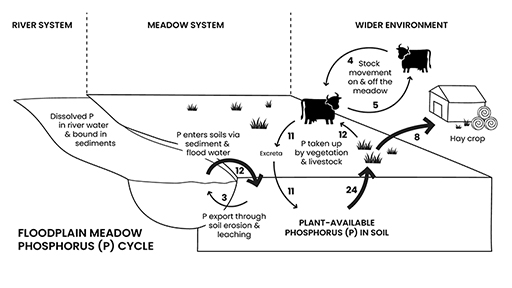2 Nutrient cycling in floodplains

The availability of nutrients in floodplains is determined by the input from floods and the output, primarily in the form of a hay crop. A comparison of these fluxes is called a nutrient budget.
If nutrient arriving in floods exceeds the amount removed in hay, the soils will increase in fertility and tall, competitive species of grass (such as tall oat and cocksfoot) will dominate the meadow, reducing both botanical diversity and hay quality. On the other hand, if the floods deliver less nutrient than the hay crop removes, then the hay yield will start to decline.
Grazing animals have relatively little effect on the nutrient budget because, while they consume grass and extract nutrients for body growth, the majority (>90%) reappears at the other end as manure and returns to the soil. Managing floodplain as pasture therefore allows nutrients to build up over time and eventually leach back into the river.
Activity 1
Examine the infographic. It shows how nutrients cycle through a floodplain meadow. What would happen if the hay cut were not taken?
Discussion
The hay cut balances the nutrients that are deposited in a flood, so if it was not taken, the soil fertility would increase and plant diversity would decrease.

